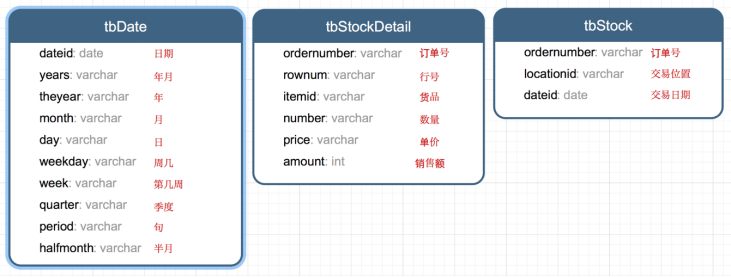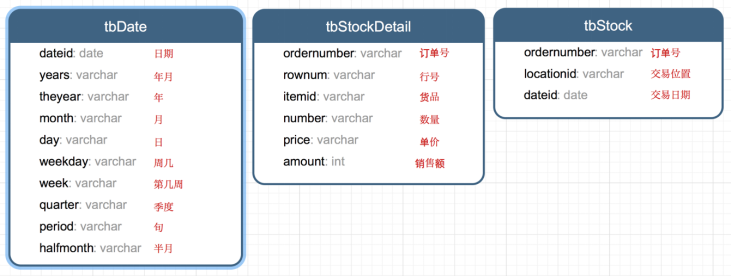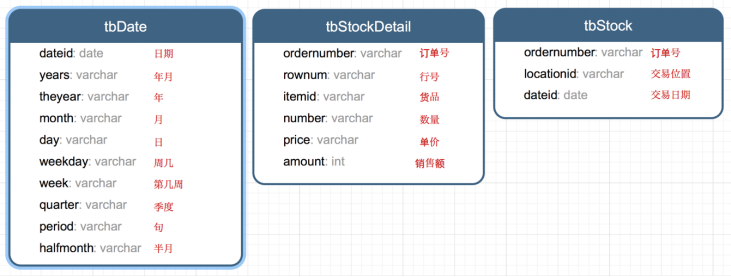第8章 Spark SQL实战
第8章 Spark SQL实战
8.1 数据说明
数据集是货品交易数据集。

每个订单可能包含多个货品,每个订单可以产生多次交易,不同的货品有不同的单价。
8.2 加载数据
tbStock:
scala> case class tbStock(ordernumber:String,locationid:String,dateid:String) extends Serializable
defined class tbStock scala> val tbStockRdd = spark.sparkContext.textFile("tbStock.txt")
tbStockRdd: org.apache.spark.rdd.RDD[String] = tbStock.txt MapPartitionsRDD[1] at textFile at <console>:23 scala> val tbStockDS = tbStockRdd.map(_.split(",")).map(attr=>tbStock(attr(0),attr(1),attr(2))).toDS
tbStockDS: org.apache.spark.sql.Dataset[tbStock] = [ordernumber: string, locationid: string ... 1 more field] scala> tbStockDS.show()
+------------+----------+---------+
| ordernumber|locationid| dataid|
+------------+----------+---------+
|BYSL00000893| ZHAO|2007-8-23|
|BYSL00000897| ZHAO|2007-8-24|
|BYSL00000898| ZHAO|2007-8-25|
|BYSL00000899| ZHAO|2007-8-26|
|BYSL00000900| ZHAO|2007-8-26|
|BYSL00000901| ZHAO|2007-8-27|
|BYSL00000902| ZHAO|2007-8-27|
|BYSL00000904| ZHAO|2007-8-28|
|BYSL00000905| ZHAO|2007-8-28|
|BYSL00000906| ZHAO|2007-8-28|
|BYSL00000907| ZHAO|2007-8-29|
|BYSL00000908| ZHAO|2007-8-30|
|BYSL00000909| ZHAO| 2007-9-1|
|BYSL00000910| ZHAO| 2007-9-1|
|BYSL00000911| ZHAO|2007-8-31|
|BYSL00000912| ZHAO| 2007-9-2|
|BYSL00000913| ZHAO| 2007-9-3|
|BYSL00000914| ZHAO| 2007-9-3|
|BYSL00000915| ZHAO| 2007-9-4|
|BYSL00000916| ZHAO| 2007-9-4|
+------------+----------+---------+
only showing top 20 rows
tbStockDetail:
scala> case class tbStockDetail(ordernumber:String, rownum:Int, itemid:String, number:Int, price:Double, amount:Double) extends Serializable
defined class tbStockDetail scala> val tbStockDetailRdd = spark.sparkContext.textFile("tbStockDetail.txt")
tbStockDetailRdd: org.apache.spark.rdd.RDD[String] = tbStockDetail.txt MapPartitionsRDD[13] at textFile at <console>:23 scala> val tbStockDetailDS = tbStockDetailRdd.map(_.split(",")).map(attr=> tbStockDetail(attr(0),attr(1).trim().toInt,attr(2),attr(3).trim().toInt,attr(4).trim().toDouble, attr(5).trim().toDouble)).toDS
tbStockDetailDS: org.apache.spark.sql.Dataset[tbStockDetail] = [ordernumber: string, rownum: int ... 4 more fields] scala> tbStockDetailDS.show()
+------------+------+--------------+------+-----+------+
| ordernumber|rownum| itemid|number|price|amount|
+------------+------+--------------+------+-----+------+
|BYSL00000893| 0|FS527258160501| -1|268.0|-268.0|
|BYSL00000893| 1|FS527258169701| 1|268.0| 268.0|
|BYSL00000893| 2|FS527230163001| 1|198.0| 198.0|
|BYSL00000893| 3|24627209125406| 1|298.0| 298.0|
|BYSL00000893| 4|K9527220210202| 1|120.0| 120.0|
|BYSL00000893| 5|01527291670102| 1|268.0| 268.0|
|BYSL00000893| 6|QY527271800242| 1|158.0| 158.0|
|BYSL00000893| 7|ST040000010000| 8| 0.0| 0.0|
|BYSL00000897| 0|04527200711305| 1|198.0| 198.0|
|BYSL00000897| 1|MY627234650201| 1|120.0| 120.0|
|BYSL00000897| 2|01227111791001| 1|249.0| 249.0|
|BYSL00000897| 3|MY627234610402| 1|120.0| 120.0|
|BYSL00000897| 4|01527282681202| 1|268.0| 268.0|
|BYSL00000897| 5|84126182820102| 1|158.0| 158.0|
|BYSL00000897| 6|K9127105010402| 1|239.0| 239.0|
|BYSL00000897| 7|QY127175210405| 1|199.0| 199.0|
|BYSL00000897| 8|24127151630206| 1|299.0| 299.0|
|BYSL00000897| 9|G1126101350002| 1|158.0| 158.0|
|BYSL00000897| 10|FS527258160501| 1|198.0| 198.0|
|BYSL00000897| 11|ST040000010000| 13| 0.0| 0.0|
+------------+------+--------------+------+-----+------+
only showing top 20 rows
tbDate:
scala> case class tbDate(dateid:String, years:Int, theyear:Int, month:Int, day:Int, weekday:Int, week:Int, quarter:Int, period:Int, halfmonth:Int) extends Serializable
defined class tbDate scala> val tbDateRdd = spark.sparkContext.textFile("tbDate.txt")
tbDateRdd: org.apache.spark.rdd.RDD[String] = tbDate.txt MapPartitionsRDD[20] at textFile at <console>:23 scala> val tbDateDS = tbDateRdd.map(_.split(",")).map(attr=> tbDate(attr(0),attr(1).trim().toInt, attr(2).trim().toInt,attr(3).trim().toInt, attr(4).trim().toInt, attr(5).trim().toInt, attr(6).trim().toInt, attr(7).trim().toInt, attr(8).trim().toInt, attr(9).trim().toInt)).toDS
tbDateDS: org.apache.spark.sql.Dataset[tbDate] = [dateid: string, years: int ... 8 more fields] scala> tbDateDS.show()
+---------+------+-------+-----+---+-------+----+-------+------+---------+
| dateid| years|theyear|month|day|weekday|week|quarter|period|halfmonth|
+---------+------+-------+-----+---+-------+----+-------+------+---------+
| 2003-1-1|200301| 2003| 1| 1| 3| 1| 1| 1| 1|
| 2003-1-2|200301| 2003| 1| 2| 4| 1| 1| 1| 1|
| 2003-1-3|200301| 2003| 1| 3| 5| 1| 1| 1| 1|
| 2003-1-4|200301| 2003| 1| 4| 6| 1| 1| 1| 1|
| 2003-1-5|200301| 2003| 1| 5| 7| 1| 1| 1| 1|
| 2003-1-6|200301| 2003| 1| 6| 1| 2| 1| 1| 1|
| 2003-1-7|200301| 2003| 1| 7| 2| 2| 1| 1| 1|
| 2003-1-8|200301| 2003| 1| 8| 3| 2| 1| 1| 1|
| 2003-1-9|200301| 2003| 1| 9| 4| 2| 1| 1| 1|
|2003-1-10|200301| 2003| 1| 10| 5| 2| 1| 1| 1|
|2003-1-11|200301| 2003| 1| 11| 6| 2| 1| 2| 1|
|2003-1-12|200301| 2003| 1| 12| 7| 2| 1| 2| 1|
|2003-1-13|200301| 2003| 1| 13| 1| 3| 1| 2| 1|
|2003-1-14|200301| 2003| 1| 14| 2| 3| 1| 2| 1|
|2003-1-15|200301| 2003| 1| 15| 3| 3| 1| 2| 1|
|2003-1-16|200301| 2003| 1| 16| 4| 3| 1| 2| 2|
|2003-1-17|200301| 2003| 1| 17| 5| 3| 1| 2| 2|
|2003-1-18|200301| 2003| 1| 18| 6| 3| 1| 2| 2|
|2003-1-19|200301| 2003| 1| 19| 7| 3| 1| 2| 2|
|2003-1-20|200301| 2003| 1| 20| 1| 4| 1| 2| 2|
+---------+------+-------+-----+---+-------+----+-------+------+---------+
only showing top 20 rows
注册表:
scala> tbStockDS.createOrReplaceTempView("tbStock")
scala> tbDateDS.createOrReplaceTempView("tbDate")
scala> tbStockDetailDS.createOrReplaceTempView("tbStockDetail")
8.3 计算所有订单中每年的销售单数、销售总额
统计所有订单中每年的销售单数、销售总额
三个表连接后以count(distinct a.ordernumber)计销售单数,sum(b.amount)计销售总额

SELECT c.theyear, COUNT(DISTINCT a.ordernumber), SUM(b.amount)
FROM tbStock a
JOIN tbStockDetail b ON a.ordernumber = b.ordernumber
JOIN tbDate c ON a.dateid = c.dateid
GROUP BY c.theyear
ORDER BY c.theyear
spark.sql("SELECT c.theyear, COUNT(DISTINCT a.ordernumber), SUM(b.amount) FROM tbStock a JOIN tbStockDetail b ON a.ordernumber = b.ordernumber JOIN tbDate c ON a.dateid = c.dateid GROUP BY c.theyear ORDER BY c.theyear").show
结果如下:
+-------+---------------------------+--------------------+
|theyear|count(DISTINCT ordernumber)| sum(amount)|
+-------+---------------------------+--------------------+
| 2004| 1094| 3268115.499199999|
| 2005| 3828|1.3257564149999991E7|
| 2006| 3772|1.3680982900000006E7|
| 2007| 4885|1.6719354559999993E7|
| 2008| 4861| 1.467429530000001E7|
| 2009| 2619| 6323697.189999999|
| 2010| 94| 210949.65999999997|
+-------+---------------------------+--------------------+
8.4 计算所有订单每年最大金额订单的销售额
目标:统计每年最大金额订单的销售额:

1)统计每年,每个订单一共有多少销售额
SELECT a.dateid, a.ordernumber, SUM(b.amount) AS SumOfAmount
FROM tbStock a
JOIN tbStockDetail b ON a.ordernumber = b.ordernumber
GROUP BY a.dateid, a.ordernumber
spark.sql("SELECT a.dateid, a.ordernumber, SUM(b.amount) AS SumOfAmount FROM tbStock a JOIN tbStockDetail b ON a.ordernumber = b.ordernumber GROUP BY a.dateid, a.ordernumber").show
结果如下:
+----------+------------+------------------+
| dateid| ordernumber| SumOfAmount|
+----------+------------+------------------+
| 2008-4-9|BYSL00001175| 350.0|
| 2008-5-12|BYSL00001214| 592.0|
| 2008-7-29|BYSL00011545| 2064.0|
| 2008-9-5|DGSL00012056| 1782.0|
| 2008-12-1|DGSL00013189| 318.0|
|2008-12-18|DGSL00013374| 963.0|
| 2009-8-9|DGSL00015223| 4655.0|
| 2009-10-5|DGSL00015585| 3445.0|
| 2010-1-14|DGSL00016374| 2934.0|
| 2006-9-24|GCSL00000673|3556.1000000000004|
| 2007-1-26|GCSL00000826| 9375.199999999999|
| 2007-5-24|GCSL00001020| 6171.300000000002|
| 2008-1-8|GCSL00001217| 7601.6|
| 2008-9-16|GCSL00012204| 2018.0|
| 2006-7-27|GHSL00000603| 2835.6|
|2006-11-15|GHSL00000741| 3951.94|
| 2007-6-6|GHSL00001149| 0.0|
| 2008-4-18|GHSL00001631| 12.0|
| 2008-7-15|GHSL00011367| 578.0|
| 2009-5-8|GHSL00014637| 1797.6|
+----------+------------+------------------+
2)以上一步查询结果为基础表,和表tbDate使用dateid join,求出每年最大金额订单的销售额
SELECT theyear, MAX(c.SumOfAmount) AS SumOfAmount
FROM (SELECT a.dateid, a.ordernumber, SUM(b.amount) AS SumOfAmount
FROM tbStock a
JOIN tbStockDetail b ON a.ordernumber = b.ordernumber
GROUP BY a.dateid, a.ordernumber
) c
JOIN tbDate d ON c.dateid = d.dateid
GROUP BY theyear
ORDER BY theyear DESC
spark.sql("SELECT theyear, MAX(c.SumOfAmount) AS SumOfAmount FROM (SELECT a.dateid, a.ordernumber, SUM(b.amount) AS SumOfAmount FROM tbStock a JOIN tbStockDetail b ON a.ordernumber = b.ordernumber GROUP BY a.dateid, a.ordernumber ) c JOIN tbDate d ON c.dateid = d.dateid GROUP BY theyear ORDER BY theyear DESC").show
结果如下:
+-------+------------------+
|theyear| SumOfAmount|
+-------+------------------+
| 2010|13065.280000000002|
| 2009|25813.200000000008|
| 2008| 55828.0|
| 2007| 159126.0|
| 2006| 36124.0|
| 2005|38186.399999999994|
| 2004| 23656.79999999997|
+-------+------------------+
8.5 计算所有订单中每年最畅销货品
目标:统计每年最畅销货品(哪个货品销售额amount在当年最高,哪个就是最畅销货品)

第一步、求出每年每个货品的销售额
SELECT c.theyear, b.itemid, SUM(b.amount) AS SumOfAmount
FROM tbStock a
JOIN tbStockDetail b ON a.ordernumber = b.ordernumber
JOIN tbDate c ON a.dateid = c.dateid
GROUP BY c.theyear, b.itemid
spark.sql("SELECT c.theyear, b.itemid, SUM(b.amount) AS SumOfAmount FROM tbStock a JOIN tbStockDetail b ON a.ordernumber = b.ordernumber JOIN tbDate c ON a.dateid = c.dateid GROUP BY c.theyear, b.itemid").show
结果如下:
+-------+--------------+------------------+
|theyear| itemid| SumOfAmount|
+-------+--------------+------------------+
| 2004|43824480810202| 4474.72|
| 2006|YA214325360101| 556.0|
| 2006|BT624202120102| 360.0|
| 2007|AK215371910101|24603.639999999992|
| 2008|AK216169120201|29144.199999999997|
| 2008|YL526228310106|16073.099999999999|
| 2009|KM529221590106| 5124.800000000001|
| 2004|HT224181030201|2898.6000000000004|
| 2004|SG224308320206| 7307.06|
| 2007|04426485470201|14468.800000000001|
| 2007|84326389100102| 9134.11|
| 2007|B4426438020201| 19884.2|
| 2008|YL427437320101|12331.799999999997|
| 2008|MH215303070101| 8827.0|
| 2009|YL629228280106| 12698.4|
| 2009|BL529298020602| 2415.8|
| 2009|F5127363019006| 614.0|
| 2005|24425428180101| 34890.74|
| 2007|YA214127270101| 240.0|
| 2007|MY127134830105| 11099.92|
+-------+--------------+------------------+
第二步、在第一步的基础上,统计每年单个货品中的最大金额
SELECT d.theyear, MAX(d.SumOfAmount) AS MaxOfAmount
FROM (SELECT c.theyear, b.itemid, SUM(b.amount) AS SumOfAmount
FROM tbStock a
JOIN tbStockDetail b ON a.ordernumber = b.ordernumber
JOIN tbDate c ON a.dateid = c.dateid
GROUP BY c.theyear, b.itemid
) d
GROUP BY d.theyear
spark.sql("SELECT d.theyear, MAX(d.SumOfAmount) AS MaxOfAmount FROM (SELECT c.theyear, b.itemid, SUM(b.amount) AS SumOfAmount FROM tbStock a JOIN tbStockDetail b ON a.ordernumber = b.ordernumber JOIN tbDate c ON a.dateid = c.dateid GROUP BY c.theyear, b.itemid ) d GROUP BY d.theyear").show
结果如下:
+-------+------------------+
|theyear| MaxOfAmount|
+-------+------------------+
| 2007| 70225.1|
| 2006| 113720.6|
| 2004|53401.759999999995|
| 2009| 30029.2|
| 2005|56627.329999999994|
| 2010| 4494.0|
| 2008| 98003.60000000003|
+-------+------------------+
第三步、用最大销售额和统计好的每个货品的销售额join,以及用年join,集合得到最畅销货品那一行信息
SELECT DISTINCT e.theyear, e.itemid, f.MaxOfAmount
FROM (SELECT c.theyear, b.itemid, SUM(b.amount) AS SumOfAmount
FROM tbStock a
JOIN tbStockDetail b ON a.ordernumber = b.ordernumber
JOIN tbDate c ON a.dateid = c.dateid
GROUP BY c.theyear, b.itemid
) e
JOIN (SELECT d.theyear, MAX(d.SumOfAmount) AS MaxOfAmount
FROM (SELECT c.theyear, b.itemid, SUM(b.amount) AS SumOfAmount
FROM tbStock a
JOIN tbStockDetail b ON a.ordernumber = b.ordernumber
JOIN tbDate c ON a.dateid = c.dateid
GROUP BY c.theyear, b.itemid
) d
GROUP BY d.theyear
) f ON e.theyear = f.theyear
AND e.SumOfAmount = f.MaxOfAmount
ORDER BY e.theyear
spark.sql("SELECT DISTINCT e.theyear, e.itemid, f.maxofamount FROM (SELECT c.theyear, b.itemid, SUM(b.amount) AS sumofamount FROM tbStock a JOIN tbStockDetail b ON a.ordernumber = b.ordernumber JOIN tbDate c ON a.dateid = c.dateid GROUP BY c.theyear, b.itemid ) e JOIN (SELECT d.theyear, MAX(d.sumofamount) AS maxofamount FROM (SELECT c.theyear, b.itemid, SUM(b.amount) AS sumofamount FROM tbStock a JOIN tbStockDetail b ON a.ordernumber = b.ordernumber JOIN tbDate c ON a.dateid = c.dateid GROUP BY c.theyear, b.itemid ) d GROUP BY d.theyear ) f ON e.theyear = f.theyear AND e.sumofamount = f.maxofamount ORDER BY e.theyear").show
结果如下:
+-------+--------------+------------------+
|theyear| itemid| maxofamount|
+-------+--------------+------------------+
| 2004|JY424420810101|53401.759999999995|
| 2005|24124118880102|56627.329999999994|
| 2006|JY425468460101| 113720.6|
| 2007|JY425468460101| 70225.1|
| 2008|E2628204040101| 98003.60000000003|
| 2009|YL327439080102| 30029.2|
| 2010|SQ429425090101| 4494.0|
+-------+--------------+------------------+
第8章 Spark SQL实战的更多相关文章
- 第7章 Spark SQL 的运行原理(了解)
第7章 Spark SQL 的运行原理(了解) 7.1 Spark SQL运行架构 Spark SQL对SQL语句的处理和关系型数据库类似,即词法/语法解析.绑定.优化.执行.Spark SQL会先将 ...
- 第1章 Spark SQL概述
第1章 Spark SQL概述 1.1 什么是Spark SQL Spark SQL是Spark用来处理结构化数据的一个模块,它提供了一个编程抽象叫做DataFrame并且作为分布式SQL查询引擎的作 ...
- Spark SQL实战
一.程序 package sparklearning import org.apache.log4j.Logger import org.apache.spark.SparkConf import o ...
- 大数据技术之_19_Spark学习_03_Spark SQL 应用解析 + Spark SQL 概述、解析 、数据源、实战 + 执行 Spark SQL 查询 + JDBC/ODBC 服务器
第1章 Spark SQL 概述1.1 什么是 Spark SQL1.2 RDD vs DataFrames vs DataSet1.2.1 RDD1.2.2 DataFrame1.2.3 DataS ...
- Spark SQL知识点大全与实战
Spark SQL概述 1.什么是Spark SQL Spark SQL是Spark用于结构化数据(structured data)处理的Spark模块. 与基本的Spark RDD API不同,Sp ...
- Spark SQL知识点与实战
Spark SQL概述 1.什么是Spark SQL Spark SQL是Spark用于结构化数据(structured data)处理的Spark模块. 与基本的Spark RDD API不同,Sp ...
- 以慕课网日志分析为例-进入大数据Spark SQL的世界
下载地址.请联系群主 第1章 初探大数据 本章将介绍为什么要学习大数据.如何学好大数据.如何快速转型大数据岗位.本项目实战课程的内容安排.本项目实战课程的前置内容介绍.开发环境介绍.同时为大家介绍项目 ...
- 以某课网日志分析为例 进入大数据 Spark SQL 的世界
第1章 初探大数据 本章将介绍为什么要学习大数据.如何学好大数据.如何快速转型大数据岗位.本项目实战课程的内容安排.本项目实战课程的前置内容介绍.开发环境介绍.同时为大家介绍项目中涉及的Hadoop. ...
- Spark SQL 源代码分析系列
从决定写Spark SQL文章的源代码分析,到现在一个月的时间,一个又一个几乎相同的结束很快,在这里也做了一个综合指数,方便阅读,下面是读取顺序 :) 第一章 Spark SQL源代码分析之核心流程 ...
随机推荐
- 部署SpringBoot到阿里云
目录 安装Mysql 1. 下载命令 2. 进行repo的安装: 3. 安装mysql 部署SpringBoot到阿里云服务器 1.IDEA下载插件 2.进入 Preference 配置一个 Acce ...
- linux gdb 入门级教程(小白专用)
送给包含我在内的所有小白: 对于养linux真姬的本小白来说,既然你选择养它,那你就要满足他. 如果你养了它是为了码代码,那我觉得gdb应该是它的基本需求了吧?! 然而gdb哪有那些IDE来的简单啊, ...
- Oracle Dataguard故障转移(failover)操作
注意:故障转移会破坏DG的主从关系,使其变为互不相关的2个数据库,谨慎使用. (一)故障转移操作流程图 (二)故障转移操作流程 备注:以下操作步骤与上面流程图步骤一一对应 STEP1:刷新所有未发送到 ...
- PHP 太空船运算符(组合比较符)
PHP 7 新增加的太空船运算符(组合比较符)用于比较两个表达式 $a 和 $b,如果 $a 小于.等于或大于 $b时,它分别返回-1.0或1. 实例 <?php // 整型比较 print( ...
- PHP fputs() 函数
定义和用法 fputs() 函数将内容写入一个打开的文件中. 函数会在到达指定长度或读到文件末尾(EOF)时(以先到者为准),停止运行. 如果函数成功执行,则返回写入的字节数.如果失败,则返回 FAL ...
- 2020牛客暑期多校训练营 第二场 C Cover the Tree 构造 贪心
LINK:Cover the Tree 最受挫的是这道题,以为很简单 当时什么都想不清楚. 先胡了一个树的直径乱搞的贪心 一直过不去.后来意识到这类似于最经典长链剖分优化贪心的做法 然后那个是求最大值 ...
- 阿里云Redis的开发规范
作者:付磊-起扬 来源:https://yq.aliyun.com/articles/531067 本文主要介绍在使用阿里云Redis的开发规范,从下面几个方面进行说明. 键值设计 命令使用 客户端使 ...
- 笨办法学习python3练习代码:argv参数变量与文件操作
ex15.py 完成ex15.py需要在ex15.py同文件夹目录下面准备一个txt文件(ex15_sample.txt) 执行ex15.py 如: python ex15.py e ...
- Docker入坑指南之RUN
总有一些场景,我们需要自己制作一个镜像,可以快速还原环境,又不想被其他因素干扰镜像的纯净,这个时候,就可以选择Docker了,启动便捷,镜像还原很快捷,除了上手不容易. 最近入坑研究了一番,小有心得, ...
- tensorboard报错:AttributeError: ‘Value’ object has no attribute ‘metadata’
tensorboard的网页可以访问,但是只能观察到graph数据,但是观察不到scalars数据. 原因:tensorflow版本需>=1.3.0 解决方法:升级tensorflow
